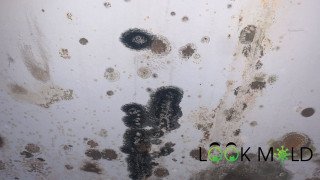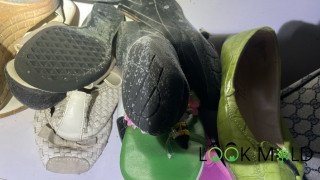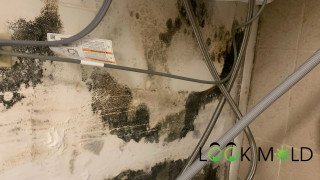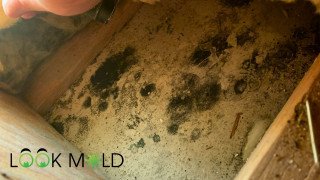Black Mold vs Mildew: Understanding the Differences
By: Licensed Mold Assessor Brad Fishbein
February 8, 2023
Black mold and mildew—two types of fungi—are sometimes uninvited, unwanted houseguests. Well, let's go with always! There's nothing good about mold or mildew, at least as it pertains to being present inside a home.
While black mold and mildew may look similar at times, there are some key differences between the two. And, you should be aware of the differences, because how you get rid of them will be very different.
In this blog post, we're going to explain:
- What black mold is
- What mildew is
- Differences between mold and mildew
- How mold and mildew grow
- Risks of black mold and mildew
- Cleaning mold and mildew
- Mildew and mold removal
- Preventing both mold and mildew
- What mold and mildew smell like
By the end of this article, you'll have to know the differences between black mold vs. mildew. You need to read all the way to the end because these two can often be confused.
As we begin, we're going to define black mold and mildew. You'll see why they're similar. But, you'll also learn why they're different. And, after all, you'll learn why that's important.
What is Toxic Black Mold?
Black mold—also known as Stachybotrys chartarum—is a type of fungus that grows in dark, moist environments such as bathrooms, basements, and attics. It is often found on damp surfaces such as drywall or wallpaper that has been exposed to moisture for long periods of time.
Stachybotrys also thrives on organic materials like wood or paper.
What is Mildew?
Mildew is type of fungus that grows in damp conditions but does not usually cause significant health problems that black mold does. We'll explain the differences in more detail later.
Mildew typically appears as a white or gray powdery substance on walls or other surfaces. Unlike black mold, mildew can usually be easily removed; however, if left untreated, it can cause discoloration of walls or furniture over time.
Differences Between Both Mold & Mildew
Both black mold and mildew both require regular cleaning and ventilation to prevent them from growing out of control. The main difference is mold penetrates building materials and uses them as a food source whereas mildew is typically just on the surface of an area with poor ventilation.
The surface fungus is typically on all sorts of building materials sometimes porous and other times not.
Another main difference between the two fungi lies in their appearance.

Case in point: Black mold typically appears black and sometimes deep green, while mildew usually appears white or gray. Stachybotrys will sometimes look like black crayon was used and will be in patterns. Mildew is usually just on the surface and looks like somebody sprinkled white powder all over.
Another major difference is one you can’t see: detrimental health effects. Later, we’ll learn which one is worse (hint: it’s the one that has “toxic” in its nickname).
It's also important to know the difference between black mold and mildew so you can properly remove them from your home, office or even under your home in your crawl spaces if necessary.
How Do Mold and Mildew Grow?
Molds reproduce by releasing microscopic fungi into the air. These spores travel through the air until they find an organic matter surface that is damp, moist, and cool enough for them to settle on.
Once on the surface, they will begin to grow and form colonies. Mold can grow on nearly any porous surface, including:
- Wood
- Paper
- Carpet
- Drywall
As molds feed off of the organic material in their environment, certain species of mold can emit toxins that can cause serious health problems if inhaled or ingested over time.
Mildews are also fungi but, unlike molds, they do not produce spores.
Instead, mildews produce small, threadlike structures called hyphae that spread out from the original colony to form new ones.

The Risks of Black Mold and Mildew in Your Home
As a homeowner, it’s important to be aware of the risks of severe health problems associated with black mold and mildew.
Which is worse? Does it matter? After all, your health is at stake either way. That being said, we're still going to explain the key differences (health-wise) between these two types of fungi.
The Health Risks of Black Mold
Black mold produces something called mycotoxins which can be harmful when inhaled over long periods of time. Exposure to mycotoxins can lead to a range of symptoms including:
- Headaches
- Asthma attacks
- Fatigue
- Respiratory problems
- Eye irritation
- Skin irritation
- Memory loss
- Allergic reactions

In extreme cases, there have been reports of long-term mold exposure such as permanent lung damage or neurological disorders but there are no official studies proving these symptoms are associated.
Mold allergies are another factor to consider. People with a mold allergy can have allergic reactions and develop severe allergy symptoms.
The Health Risks of Mildew
Mildew doesn’t produce toxins like black mold does but it can still cause problems such as allergies or asthma attacks in sensitive people who come into contact with it. More than likely when mildew is present, mold spores are typically airborne.

Which One is Worse?
Black mold is absolutely the more dangerous of the two. They call black mold toxic for nothing! Black mold produces toxins that can cause more severe reactions if inhaled over long periods of time.
So yeah....
Black Mold is MUCH worse!
Mold Removal and Mildew Removal
Mold and mildew can both damage your home by discoloring surfaces or creating foul odors. Mildew can be cleaned in most cases. Mold found indoors on the other hand, well that's a different story. It really depends on what type of surface mold is growing on and how long the material was wet.
Removing Mold and Mildew from Your Home
The first step is to ensure your environment is properly ventilated before trying to remove mold or mildew from your home. Basically, if the space is not ventilated you can expect the problem to return!

Opening the windows and doors is not always the best thing to do. The reason why is that in most climates there is more mold outside than there is inside. So if you have any wet building material, mold from outside can land on the wet building material and start to grow if the conditions are right.
Chemical Cleaners
Many products specifically designed for removing mold and mildew are available at hardware stores or online retailers.
Most people will resort to a bleach and water solution but there are better options. Many chemicals on the market are safer. If you decide to use any bleach product, just use a few drops and only use on hard non-porous surfaces.
The instructions for using chemical cleaners are easy: Just follow the instructions on the label! The instructions are there for a reason. So, follow them carefully.
Using these products incorrectly may result in additional problems. At best, the mold or mildew won't be removed. At worst, these products may be hazardous if used incorrectly.
Natural Solutions
You can also use natural solutions like vinegar or borax. These substances can clean mold and moldy surfaces.
Here's what you can try:
-
Combine vinegar with water (1 part vinegar/3 parts water).
-
Wear personal protective gear (rubber boots, gloves, etc.) and clean the fungus.
-
Ensure it dries completely.
-
Take steps to prevent it from returning.
This method is as easy as "1, 2, 3!". Well, you can add the "4". Speaking of the fourth step, you can prevent regrowth by improving ventilation in the affected area. This could involve:
- Installing fans or dehumidifiers
- Sealing cracks around windows/doors
- Adding insulation
- Replacing old carpets/furniture that may be harboring moisture
To learn more about getting rid of mold, read our mold removal articles.
Getting rid of mold and mildew doesn’t have to be difficult; however, you'll have to act fast once you identify it in your home. Acting quickly will prevent the mold or mildew from spreading more than it already has.

One thing to keep in mind is that if the moldy area is on porous building material such as drywall, it needs to be removed and you cannot just treat mold.
How to Prevent Mold and Mildew
A mold problem and/or mildew can be a nightmare for any homeowner. This, of course, depends on how bad the situation is.
For example, you might find a small amount the size of a banana behind the toilet. Or, in worse scenarios, you might find black mold covering an entire wall in an attic.
These pesky fungi–mold and mildew–thrive in dark, damp areas. That means there's a good chance they grow in uninhabited areas of a home, for example. When was the last time you went into your attic? Have you looked at your roof trusses that have been in unairconditioned since the day the home was built?
Left unchecked, mold and mildew can damage your home's structure and cause serious health problems (as mentioned earlier). So, it's important to take preventive measures as soon as possible.
Luckily, we have a comprehensive guide dedicated to preventing mold if you want to learn more about it.
In general, preventing mold and mildew includes:
- Having the right type of ventilation
- Regular cleaning
- Checking for leaks
Proper Ventilation
One of the most effective ways to prevent mold growth and mildew growth is to ensure that there is proper ventilation throughout the house. This means opening windows or turning on fans whenever possible to allow fresh air to circulate throughout the house.
This will help keep humidity levels low, which will make it much harder for mold and mildew spores to grow. Additionally, if you have an exhaust fan installed in your bathroom, make sure to use it after showering or bathing to help reduce moisture buildup in the room.
Regular Cleaning
Another important step in preventing mold and mildew growth is regular cleaning. Pay special attention to areas where moisture accumulates.
Ensure you clean these areas regularly with a disinfecting cleaner that is designed specifically for killing mold spores. Additionally, wipe up any spills or leaks as soon as possible so that they don’t have a chance to spread through the house.
Check for Leaks
Mold needs moisture in order to grow and thrive. That’s why it loves moist areas like bathrooms and attics. So, one of the best ways to prevent its growth is by checking for any leaks such as leaks or plumbing problems around your home on a regular basis.

Signs of water damage are an indication that mold could be near (or soon-to-be!). Water stains on walls or floors or musty odors coming from certain rooms tell the same story.
If you know how to prevent mold and mildew, you'll know how to prevent their stenchy odors. Let's talk about the smell of these fungi next.
Removing Mold or Mildew Odors
Many people are familiar with the musty smell of mold and mildew. But, what does it actually smell like? And how can you effectively remove the odor from your home?
In this section, we will discuss the common characteristics of mold and mildew odors, as well as offer some tips for getting rid of them. Specifically, we're going to cover:
-
Identifying the smell of both mold or mildew
-
How to remove the smell of mold or mildew
Let's learn about identifying the odor first.

Identifying Mold or Mildew Odors
Mold and mildew have a distinct musty odor that is often described as being similar to wet socks or wet cardboard. Some people also describe it as smelling like dirt or rotting leaves.
This smell is caused by the presence of certain compounds in the mold or mildew spores. Together, these compounds are known as microbial volatile organic compounds (MVOC).
Many people think black mold smells the worst. After all, remember, black mold is also called "toxic mold". And, with a name like that, there's no way it smells good!
Let's discuss removing these smells next.
Removing Mold or Mildew Odors
The first step to removing mold or mildew odors is to remove the cause of the stench. That would be the mold or mildew! Don't expect immediate results, however. Recall: Mold spores are airborne. That means you have to be patient until all of the spores have been removed.
You can start by using products specifically designed for removing mold and mildew odors. These products can be effective in eliminating existing smells.
How do they work? These specialty products typically involve a combination of enzymes and other agents that break down the molecules responsible for producing odors.
Mold and mildew can produce unpleasant odors that can linger in your home for weeks or even months after they first appear. Therefore, It’s important to identify any sources of moisture that may be contributing to their growth. That way, you can take steps to prevent further growth.

Putting it all Together
Here's the bottom line: When it comes to mold vs mildew, neither is the winner. They are both bad! And they are both unexpected house guests that can wreak havoc.
You'll need speed and determination to quickly get rid of the problem as soon as it arises. Otherwise, the mold or mildew will continue to grow and the issue will become larger.
By using the information in this post, you'll be able to have a healthier home. Therefore, you'll have healthier inhabitants as well.
Now you know how to get rid of mold or mildew. And, you know how to prevent it. What if there was a way to ensure the air in your home is as pure as possible? Now you can, with an air purifier.
Head over to our Top 5 Air Purifiers page next to learn about the best air purifiers for mold or mildew.

Meet the author: Brad Fishbein is an ACAC council-certified Microbial Investigator. In the fall of 2012, he became a Licensed Mold Assessor in the State of Florida through the Department of Business & Professional Regulation. Brad has helped homeowners with over 5,000 successfully completed Mold Inspections since 2009.

